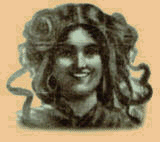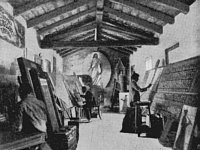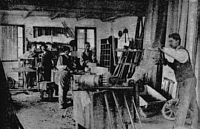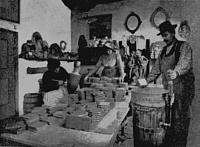 |
The Art
applied to Industry |
 The concept of art applied to industry, which might surprise
today's reader, was very widespread among the more active industries in the last quarter
of the 1800's, for example in Tuscany and Lombardy. The products prepared exclusively for
participation in the fairs and exhibitions were numerous and oftentimes the search for
innovations and success led to great extravagance; Gregorio realised this and he claimed
it often in documents of the times when he proclaimed the practicality of applied art,
"where the idea of decoration returns and can repeat itself as in a cycle of work and
the materiality of the execution is assigned, in a general way, to many workers under the
guidance of a master or the director of a workshop."
The concept of art applied to industry, which might surprise
today's reader, was very widespread among the more active industries in the last quarter
of the 1800's, for example in Tuscany and Lombardy. The products prepared exclusively for
participation in the fairs and exhibitions were numerous and oftentimes the search for
innovations and success led to great extravagance; Gregorio realised this and he claimed
it often in documents of the times when he proclaimed the practicality of applied art,
"where the idea of decoration returns and can repeat itself as in a cycle of work and
the materiality of the execution is assigned, in a general way, to many workers under the
guidance of a master or the director of a workshop."
 He wrote, "The industry, when rendered
harmonious in its works, elevates itself almost to the power of art, and thus, the worker
becomes artist and man is transformed: the industry does not make things, but rather
expresses the concept of the artist, and the modest daughter of the work but clothes
herself in rich vestments, with luminous symbols, to create flashes of light and moral
satisfactions." These affirmations are from 1905, but already many years before they
had given an artistic impulse to the production of the kilns, pursuing the ideal of a
beauty which even the common worker could attain.
He wrote, "The industry, when rendered
harmonious in its works, elevates itself almost to the power of art, and thus, the worker
becomes artist and man is transformed: the industry does not make things, but rather
expresses the concept of the artist, and the modest daughter of the work but clothes
herself in rich vestments, with luminous symbols, to create flashes of light and moral
satisfactions." These affirmations are from 1905, but already many years before they
had given an artistic impulse to the production of the kilns, pursuing the ideal of a
beauty which even the common worker could attain.
The artist's salon. In this salon numerous artists worked side by side with the labourers in the laboratories, realising that concept of art applied to industry. In those times it was deeply felt for the influence of the other European influences and proposed by Gregorio in many of his writings. The relationships with the foreign cultural movements were continuous and the Kilns had relationships not only with the representatives of Japanese art, but also felt the charm of the other ideologies which broke the ties with the past and took a peek at the bastions of art nouvelle. French, English, German, and Hungarian publications were consulted by the artists who then recreated their inspirations working with clay and painting on tiles.
In this salon numerous artists worked their craft and met each other freely, even those from a culture very different from that of the kilns. They came to experiment with new things, perfect their new proposals and then paint, model, and decorate their works. Many Italian publications were at their disposal, as well as French, Hungarian, Japanese, German and English ones, too.
 Next to
this salon for the artists there were other laboratories dedicated to the manufacture and
painting of terracotta vases, to woodworking and to blacksmiths. All of the work done in
the laboratories was supervised by the artists and the owner, who collaborated in the
realisation of the new proposals.
Next to
this salon for the artists there were other laboratories dedicated to the manufacture and
painting of terracotta vases, to woodworking and to blacksmiths. All of the work done in
the laboratories was supervised by the artists and the owner, who collaborated in the
realisation of the new proposals.
Out of this came works of large as well as small dimensions, in line with the tastes of the late nineteenth century either in the floral style or the trends of the 1920's. The reproductions of the period photographs on this page illustrate some of the friezes in ceramic on a painted wood supports, large mural friezes, and a piece of a famous Laurenti frieze shown at the Biennale of Venice in 1903.
This last represented a very important commitment for the kiln, as can be deduced in a letter by Gregorio Gregorj to the secretary of the Biennale, written on 23 March 1903, in which he says, among other things:
"…I thank you for the speed with which you have sent me the letters about the framework supports that are being finished in the Laurenti room.
Now I would pray that you would be so courteous as to indicate with a simple sketch the profile of the frame, or better, tell me the dimensions of the frames within which the frieze must stay, which is now being completed here… On my part, the work is being done day and night sparing no time, workers, fire, coal or cost if only to be able to finish the project: but with an area of 621 square metres, it is no small task to pass the frieze 4 or 5 times through the fire.
One by one as the pieces which are being prepared are put into the frames, I will begin the packing as soon as possible."

|